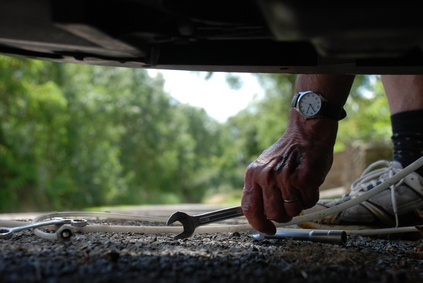
The transmission fluid in a Mitsubishi should be changed between 15,000 and 30,000 miles, depending on your driving conditions. Since a transmission is more likely to undergo a hefty amount of strain in highly polluted areas, it is possible that thickened sludge and harmful particles would enter your transmission closer to the 15,000 mile-mark. Cars that typically drive less busy roads in suburban areas may be stretched to every 30,000 miles for a routine transmission fluid change. Either way, if you are familiar with working on cars and have the necessary tools, changing your own transmission fluid can be done in an hour's time or less.
Prepare your transmission fluid for drainage by driving your Mitsubishi for at least 10 minutes prior to beginning. This will heat the transmission, allowing the fluid to drain more completely.
Elevate your car at least 6 inches off the ground using a car jack, so that you can work comfortably underneath it. It is extremely important that your car is evenly elevated so that the transmission pan isn't tipped when you remove it.
Support the jack using four jack stands next to the inner side of each tire before getting under your car.
Place your drip pan beneath the transmission pan under the front of your car. The transmission pan on a Mitsubishi is located at the underside of your transmission, closer to the driver's side front of the car.
Uncap the drain plug at the center of the transmission pan. Beware that hot fluid will pour out, so stay physically clear of the transmission pan as soon as the cap is released. Your drip pan on the ground is intended to catch the draining fluid.
Use your 17mm socket wrench to unscrew the other bolts from your transmission pan after the fluid seems to have stopped dripping from the transmission pan.
Dump any leftover old transmission fluid from the floor of the transmission pan into your drain pan.
Clean the transmission pan using a small amount of degreaser on your shop rag. Any old fluid remaining in the pan could contaminate the new fluid, so it is important to wipe the pan thoroughly.
Replace the transmission pan by screwing the bolts back into place using your socket wrench.
Remove the four jack stands and lower your car back to ground level using the car jack.
Uncap the fill plug on the top of your transmission and set it aside.
Insert your funnel into the fill plug to avoid unnecessary spills.
Add the first qt. of transmission fluid, using caution not to let it squirt out of the bottle too fast.
Start your engine with your emergency brake engaged.
Shift your Mitsubishi into each gear with your foot on the brake pedal in order to push the fluid through every component of the transmission.
Pour the second qt. of transmission fluid into the funnel and fill plug. The engine should still be running at this point and the emergency brake should still be all the way to the floor for safety purposes.
Put the transmission into every gear again, encouraging the fluid to run through the transmission system.
Check the transmission fluid level using a screwdriver to ensure that the fluid has reached the top of the transmission. Mitsubishis do not typically come with a dipstick, but as long as the fluid is not overflowing, it is not too full because the level will go down a bit after the first couple drives.
Replace the fill plug cap and close the hood of your car.
Release your emergency brake and turn your car off. Your Mitsubishi transmission fluid is good to drive at least another 15,000 miles.